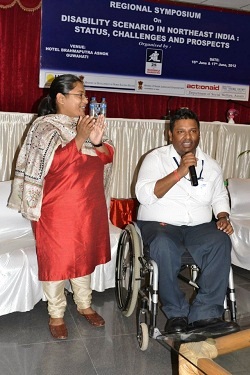The Northeast region is a unique story in itself. It holds up a mirror to India and reflects the country's contradictions and strengths, the country's historical transgressions and future expectations. This is why the media in the Northeast are important - because they, in turn, hold up a mirror to the region.
Where does the power of the media come from? It ultimately stems from their ownership of the power to interpret, reproduce and disseminate information. The media really represent a public sphere providing space for issues of importance to be discussed and debated; they together comprise a major source of information and images, which are essential for greater citizen participation. Just as they link individuals in society with the collective that is society, they provide a crucial connection between the "parts" of the country and it's whole.
So for both these reasons, defining the idea of the country and deciding how our times are to be interpreted, efforts like The Thumb Print are valuable to challenge the way the largely Delhi-centric mainstream media defines India, decide news priorities and capture contemporary realities.
The Thumb Print model rests on the promise of the internet. Today India has a tele-density that could not have been dreamt even a decade ago. Clearly great transformations are in store for this region in an era where communications technologies have shrunk both time and space.
According to projections, the Indian internet user base, which crossed the 100 million mark in November, will accelerate as more users get online on an array of devices that includes smart phones and tablets. At the present rate, in the next three years the number of internet users will be in excess of 300 million. India already has the third largest internet user base in the world, and is only behind China and the USA in this respect.
The flattening of the world, that the New York Times journalist, Thomas Friedman talked about; this killing of distance, could mean that a region like the Northeast, instead of constituting just India's periphery, could be as close to the country's centre, as any other region. It could prove that the Northeast, instead of being on the "margins" of the nation, could be the vital bridge between India and East Asia. Thus it could turn the "mainland" and "periphery" argument on its head.
I remember a conversation I once had with Assam Chief Minister Tarun Gogoi. He made his case for Assam and the Northeast with these words: "If change has to come to the region, it will have to come through Guwahati. Apart from Sikkim, Assam is the corridor to not just the Northeast but Southeast Asia -- a simple geographical fact that cannot be overlooked."
The Government of India (GOI) took a while to wake up to the transforming the region's geo-political state. But the first evidence of its awakening from slumber was when it earmarked 10 per cent of Eleventh Plan Outlay for the Northeast, which is populated by just 3.8 per cent of the population. GOI, make no mistake, was doing this for its own interests. It was looking at drawing future dividends from the fact that northeastern states share borders with Myanmar, Bangladesh and Bhutan - and of course China, countries which in turn are docked into the economic hub that is Southeast Asia. Already Korea and Thailand have begun displaying a strong interest in the Northeast.
One may say a region like the Northeast that has not figured on the national map for the last half century, which is completely landlocked, certainly needs the attention of the Indian government. It needs roads, health centres, vocational training institutions, rural electrification projects, telecom and jobs -- as of yesterday. But if local people are not given ownership of these plans of transformation, a stake in the changes envisaged in them, it will only foment existing resentments and reinforce old lines of polarization.
We will then see the cycle of violence and repression continue in the years ahead.
The uncertain trajectory that marked the presence of the Uranium Corporation of India Limited's presence in Meghalaya is a case in point. The international norm of free, prior and informed choice exercised by people most affected has to be the guiding principle of any project, be it the construction of dam, the sanctioning of mines or the setting up of industries. The old raze-and-plunder approach of a rapacious order cannot be sustained in the era of new information technologies and communication aids. It will have to be replaced by a genuine participatory process of development that is sensitive first and above all to local needs and sentiments. It has implications for military mobilization in the region, as well as in the use of repressive instruments like the Armed Forces (Special Powers) Act.
We are talking here of sustainable, people-centric change with responsibility, which the media - including new ventures like The Thumb Print - could reflect, direct and deepen.
Find us on facebook: facebook.com/TheThumbPrintMag







































